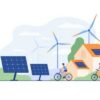Direct Drive (Gearless) Wind Turbine Market Summary:
The direct drive (gearless) wind turbine market is experiencing significant growth and is expected to continue its upward trajectory in the coming years. These innovative wind turbines have gained popularity due to their numerous advantages over traditional geared wind turbines. One of the key benefits of direct drive wind turbines is their enhanced efficiency. By eliminating the need for a gearbox, these turbines reduce mechanical losses and increase overall energy conversion efficiency. This means that more wind energy can be harnessed and converted into electricity, resulting in higher power output and improved performance. Moreover, direct drive wind turbines are known for their reliability and durability. With fewer moving parts, there is less wear and tear, reducing the need for frequent maintenance and repairs. This not only saves costs but also ensures a longer lifespan for the turbines, making them a more sustainable and cost-effective option in the long run.
In addition to their technical advantages, direct drive wind turbines also offer environmental benefits. As they operate without gears, they produce less noise and vibration, minimizing their impact on surrounding ecosystems and communities. Furthermore, their compact design allows for easier transportation and installation, making them suitable for a wide range of locations, including offshore wind farms. The global direct drive wind turbine market is witnessing significant growth due to increasing investments in renewable energy and the growing demand for clean and sustainable power sources. Countries around the world are recognizing the importance of transitioning to renewable energy to combat climate change and reduce dependence on fossil fuels. The direct drive (gearless) wind turbine market is poised for continued growth as these turbines offer enhanced efficiency, reliability, and environmental benefits. With the increasing focus on renewable energy, these turbines are playing a crucial role in meeting the world’s energy needs while minimizing environmental impact.
Direct Drive (Gearless) Wind Turbine Market Overview:
The Direct Drive (Gearless) Wind Turbine Market overview provides a comprehensive understanding of the analyzed market. It includes an introduction to the market, its size, growth rate, and key trends. This aims to give clients a broad understanding of the market landscape. The market analysis of the Direct Drive (Gearless) Wind Turbine Market delves deeper into the market dynamics, focusing on factors such as market drivers, challenges, and opportunities. It explores the macroeconomic and microeconomic factors affecting the market, industry regulations, and emerging market trends. The analysis provides valuable insights into the current and future market conditions.
The assessment of the Direct Drive (Gearless) Wind Turbine Market is performed by taking various factors into consideration, like, for instance, the business expansion policies of key players, competitive analysis of the progress of new entrants and emerging players, and the revenue, financial, and opportunity analysis of market players. The also analyzed based on regional segmentation, type or technique, end-user spectrum, etc. This research implements the latest methodologies to help clients understand the overall market scenario and strategize accordingly. The Direct Drive (Gearless) Wind Turbine Market report provides an overview of the different types of analysis conducted during the market research process, including but not limited to SWOT analysis, Porter's Five Forces analysis, PESTLE analysis, and market forecasting. These analyses provide a deeper understanding of the market dynamics and assist in making informed business decisions.
Major players included in the Direct Drive (Gearless) Wind Turbine Market:
- Alstom
- American Superconductor Corp.
- Avantis Energy Group
- Emergya Wind Technologies B.V.
- Enercon GmbH
- GE Energy
- Godecke Energie and Antriebstechnik GmbH
- Goldwind Science & Technology Co. Ltd.
- Lagerwey Wind BV
- Leitwind AG
- M. Torres Olvega Industrial S.A.
- Northern Power Systems Inc.
- Qingdao Hengfeng Wind Power Generator Co. Ltd.
- Regen Powertech Pvt. Ltd.
- Siemens Wind Power A/S
Direct Drive (Gearless) Wind Turbine Market Segmentation:
By Capacity
- Less Than 1 MW
- 1 MW to 3 MW
- More Than 3 MW
By Turbine Technology
- Electrically Excited Synchronous Generator (EES)
- Permanent Magnet Synchronous Generator (PMSG)
Future Market Analytics Focus Points:
- SWOT Analysis
- Key Market Trends
- Key Data -Points Affecting Market Growth
- Revenue and Forecast Analysis
- Growth Opportunities For New Entrants and Emerging Players
- Key Player and Market Growth Matrix
Direct Drive (Gearless) Wind Turbine Market Competitive Analysis:
The competitive analysis of the Direct Drive (Gearless) Wind Turbine Market assesses the competitive landscape of the market. It includes evaluating key players in the industry, their market share, business strategies, and competitive advantages. The competitive analysis also highlights the strengths and weaknesses of major competitors, allowing clients to understand the competitive positioning of companies operating in the market.
Objectives of the Study:
- To provide a comprehensive analysis on the Direct Drive (Gearless) Wind Turbine Market by segmentation and by region
- To cater extensive insights on factors influencing the market growth (drivers, restraints, industry-specific restraints, business expansion opportunities)
- To anticipate and analyse the market size expansion in key regions- North America, Europe, Asia Pacific, Latin America and Middle East and Africa
- To record and evaluate competitive landscape mapping- strategic alliances and mergers, technological advancements and product launches, revenue and financial analysis of key market players
How our market research reports help clients:
Our market research reports provide valuable insights to clients in their decision-making process and support their growth and market capture efforts. They offer:
- Comprehensive understanding of market trends, dynamics, and growth potential.
- Identification of niche markets and emerging opportunities.
- Assessment of competitive landscape and strategic benchmarking.
- Insights into consumer preferences, buying behavior, and market demand.
- Risk assessment and mitigation strategies.
- Market forecasting and trend analysis for informed business planning.
- Understanding product development, pricing, and other strategies.
In case of any specific requirements or changes to the current table of content based on your scope, please contact us at: enquiry@futuremarketanalytics.com






















